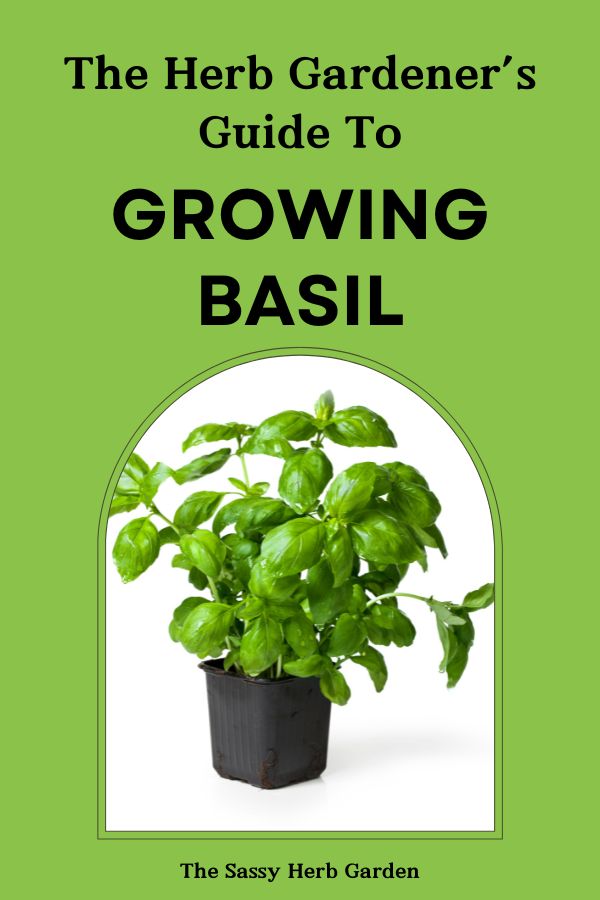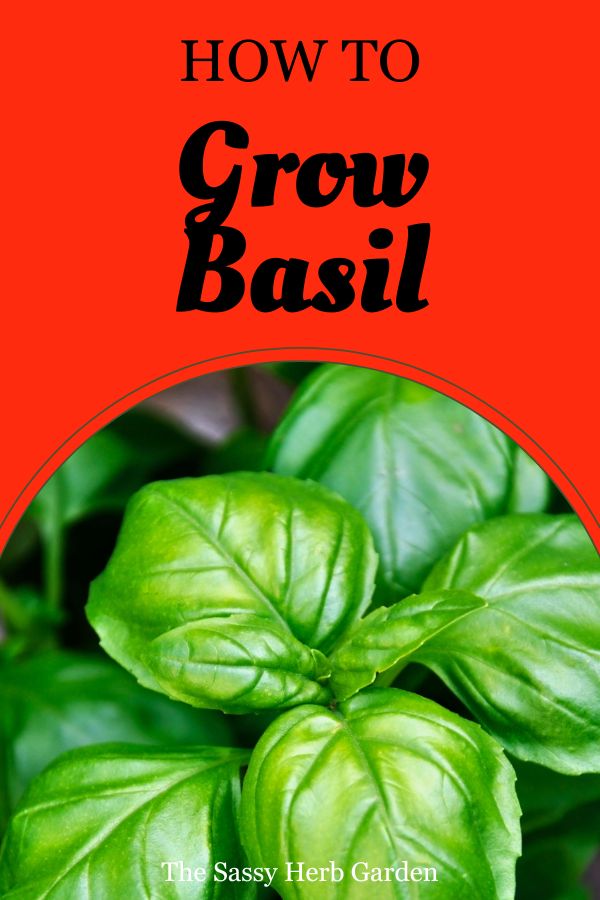The fragrance and taste of fresh basil simmering in your favorite pasta dish is the ultimate comfort moment. Growing basil is one of the easiest herbs to grow and I recommend that every beginner include this lovely plant in their herb garden. It was the ease with which basil and sage grew in my window garden that inspired me to expand my herb garden. You too can have a bountiful supply of this yummy herb right in your own backyard. In this article, we will guide you through the process of how to grow basil easily and in abundance.
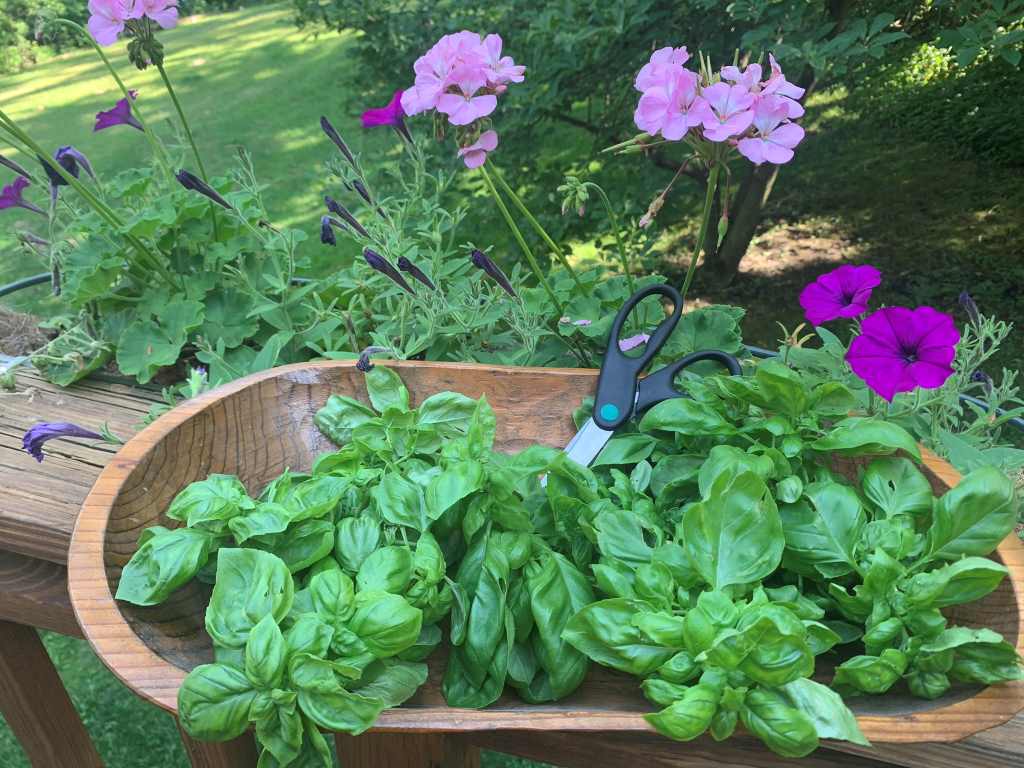
By growing your own basil, you are sure to have the freshest and most intense flavor. As an addition to your culinary creations, you will love using fresh basil over dried for the incredible way it enhances your food. There are many different cultivars of basil, each with it’s own unique taste.
- I love using the sweet basil I’ve grown to make Pesto, a classic Italian sauce made with fresh basil, garlic, pine nuts, parmesan cheese and olive oil. Yum!
- Most Italian tomato based sauces include sweet basil, from pizza to spaghetti.
- The cultivar known as Thai basil is used in many Asian dishes. It has more of a licorice flavor than Sweet Basil, but is grown in the same way.
- Did you know you can make tea from fresh basil? Simply steep fresh basil leaves in hot water for a few minutes and sweeten with honey or sugar to taste.
- The strong fragrance of basil helps keep many garden insects away from the other plants in your garden making it an excellent companion plant. That same fragrance will help deter mosquitoes if you place a few pots around your patio.
- According to WebMD, basil contains many vitamins and minerals, as well as antioxidants such as lutein, zeaxanthin, beta-carotene, and beta-cryptoxanthin.
This article may contain affiliate links to products that we mention, if you buy something through one of those links we may earn a small commission at no extra charge to you.
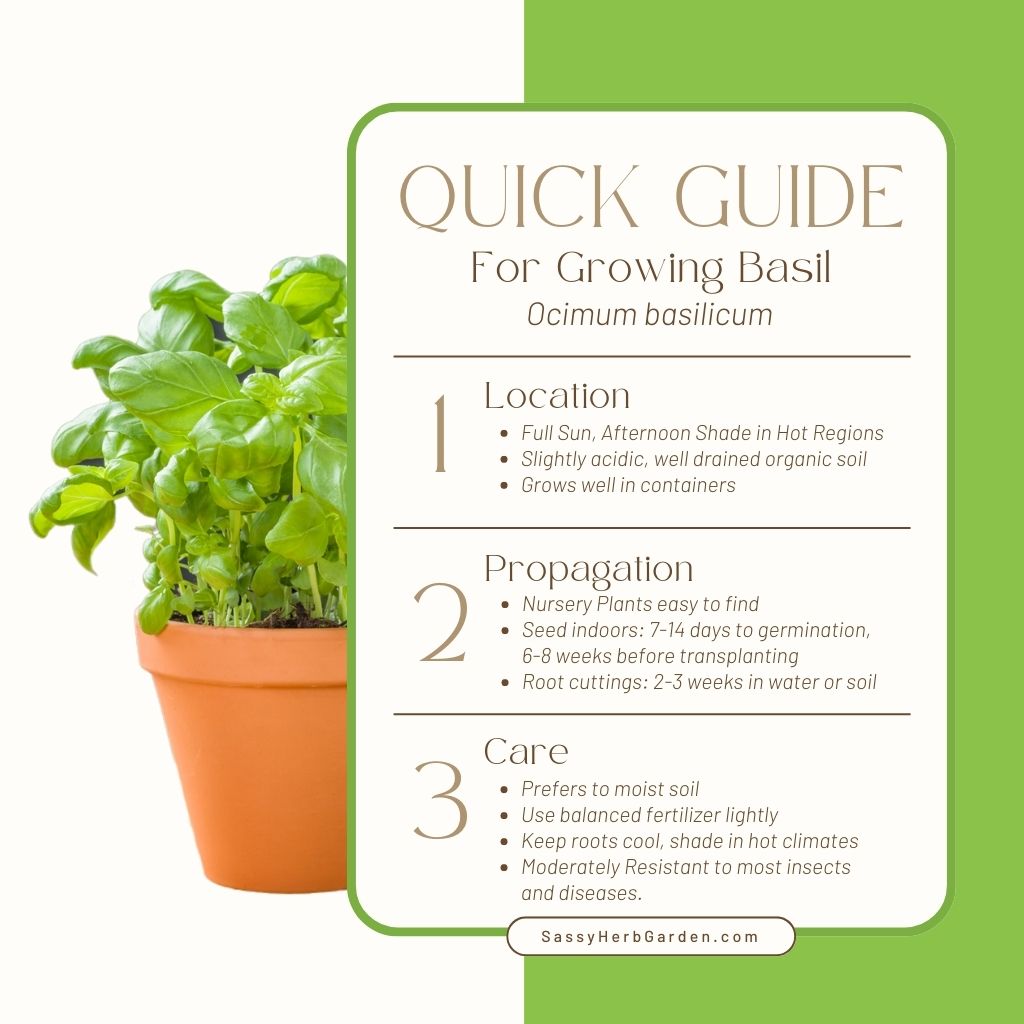
Getting Started Growing Basil
Growing basil is easy. Whether you’re a beginner or an experienced gardener, you can enjoy fresh and flavorful basil all season long. In this section, we’ll cover the basics of getting started with propagating basil.
Growing Basil from Seeds
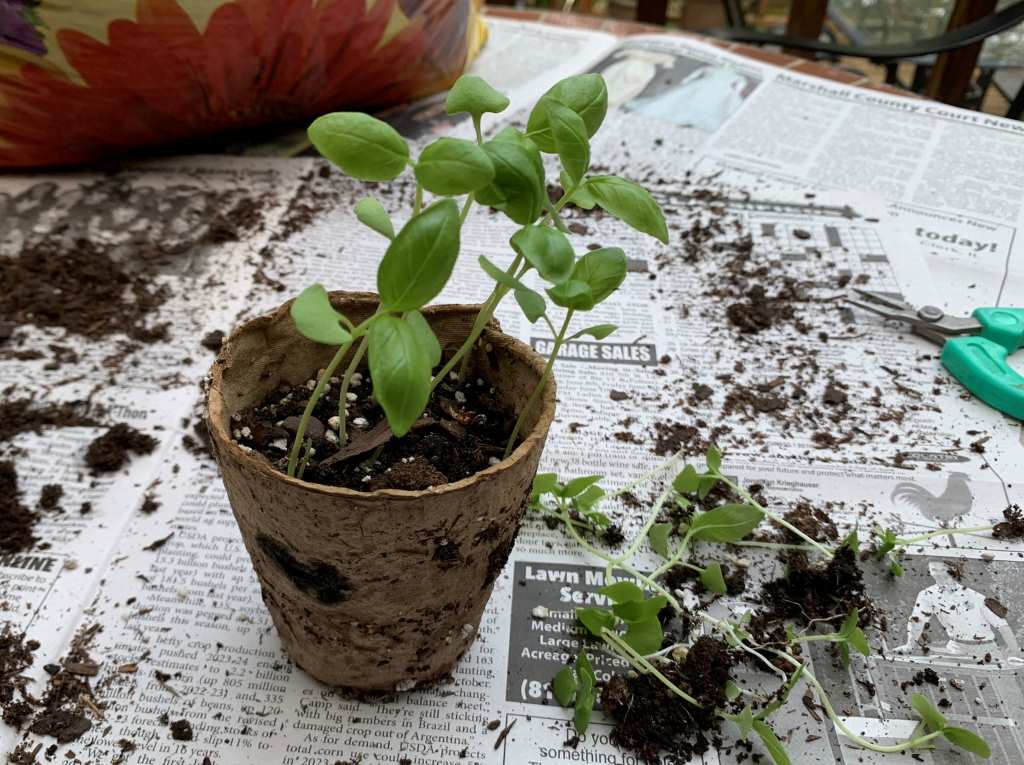
Sowing basil seeds is an easy way to start growing basil. My 4 year old grandson can do it… so you can too! Now he loves to come over and smell the basil that he grew. Start seeds 6 to 8 weeks before the last frost in your area. Here are the steps to follow:
- Fill a seed starter tray or small pots with seed-starting mix.
- Moisten the mix with water.
- Sprinkle the seeds on top of the mix, spacing them about 1/4 inch apart and cover the seeds with 1/4 inch of seed-starting mix.
- Mist the seeds with water and cover the tray or pots with a plastic dome or plastic wrap to create a mini greenhouse.
- Place the tray or pots in a warm, bright location, but out of direct sunlight.
- Keep the soil moist by misting it with water as needed.
- Basil seeds germinate in 7-14 days. Thin the seedlings to 1-2 plants per pot or at least 4 inches apart in a seed tray.
- Once the seedlings have two sets of true leaves, they can be transplanted to a bigger pot or into your garden. But… wait at least 2 weeks after the last frost since Basil likes a warm soil and will stagnate if planted in the garden too soon.
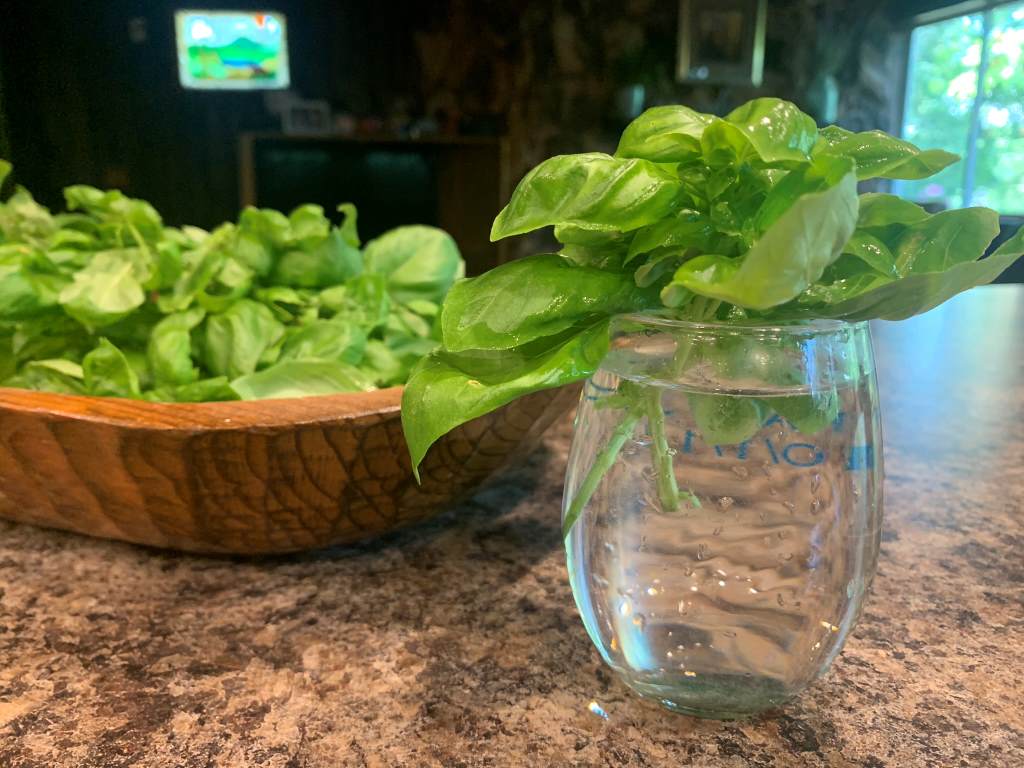
Rooting Cuttings to Propagate Basil
You can root cuttings from established basil plants. It’s a great way to share unusual varieties with friends. I like to root a few cuttings mid summer to start a new pot of basil that I can keep in my window garden over the winter. I’ve found the basil pots growing on my deck get way too big to bring in to my limited space kitchen garden for the winter. Here’s how to start basil cuttings:
- Clip stems of basil that are 5-6 inches long.
- Remove all leaves from the bottom 1/2 of the stem. Make sure you have at least 2 sets of leaf nodes (the place where you stripped the leaves) exposed.
- If using the water method:
- Place stem in clear glass of water submerging the stripped leaf nodes.
- Change the water every 2-3 days.
- When you have 1-2 inches of root growth transplant into a fine potting soil and let continue to develop before placing outside.
- If rooting directly in soil:
- Dipping the stems into a rooting hormone will improve your rate of developing healthy roots. Dip in rooting hormone and then stick the root into a seed starter soil. You’ll usually have success without the rooting hormone, but since it is so cheap I like using it for the extra insurance of fast and healthy root growth.
- Keep the soil on the moist side, but make sure excess water drains out of the pot.
- Roots usually develop in 2-3 weeks, then let grow in soil for another 2-3 weeks before transplanting outside. Make sure you are a couple of weeks past the last frost date since basil likes a warm soil.
Buying Nursery Grown Seedlings
With absolutely no embarrassment, you’ll find me picking through the herb plants at our local garden center. Usually I’ve procrastinated on starting seeds way too long. Other times, I’m looking for an interesting variety that I’m missing. You can find really healthy plants ready to plant into your garden with no fuss and no mess!
The only challenge I have with nursery grown basil plants is that they don’t always have the variety or cultivar on the label. This year I ended up with a basil plant that definitely isn’t traditional sweet basil and I’m still trying to figure out what it is. Luckily my kitchen plant exploded when I moved it to the deck for the summer so I’m not dependent on the unknown cultivar to fill my freezer.
Nursery Seedlings vs Growing from Seed vs Rooting Cuttings: Pros and Cons
When it comes to growing basil, you have three options: nursery seedlings, growing from seed or rooting cuttings. Here are the pros and cons of each:
NURSERY SEEDLINGS
Pros:
- Instant gratification – Plants are usually already 4-6 inches tall
- No waiting for germination or seedlings dying.
- No mess of starting seeds.
Cons:
- More expensive than growing from seed.
- Usually Very Limited selection – you may not find the exact variety you want.
GROWING FROM SEED
Pros:
- Cheaper than nursery seedlings.
- Wide selection – you can choose from a variety of basil seeds.
- Satisfaction of growing from scratch.
Cons:
- Takes more time and patience.
- Risk of seedlings dying or not germinating.
- Need to provide specific growing conditions.
ROOTING CUTTINGS
Pros:
- Cheaper than nursery seedlings.
- More Varieties can be collected.
- Ready to plant outside in about 1/2 the time of seed germinated plants.
Cons:
- Takes more time and patience.
- Risk of cuttings not producing roots or transplanting easily.
When first learning how to grow basil, you really can’t grow wrong with any of these methods for propagating basil. Go with what will be easiest for you to achieve your goal of growing amazing basil plants.
Planting Basil in the Garden
When it comes to growing basil in your garden, there are a few things you need to keep in mind. In this section, we’ll cover the light requirements and soil preparation needed to grow healthy basil plants.
Light Requirements of Basil
Basil is a sun-loving plant that requires at least 6 hours of direct sunlight each day. While basil loves sunlight, it’s not so fond of heat. So if you live in a climate that is consistently over 90 degrees in the afternoon basil will do better with morning sun and shade during the hottest part of the afternoon.
Basil grows extremely well in a kitchen garden in a window where it gets plenty of sunshine. It will also thrive under grow lights.
Soil Preparation for Basil
Basil prefers well-draining soil that is rich in organic matter. Before transplanting basil, work your soil so it is a fine loose soil in an area of at least 12 inches wide and 8 inches deep. Add a lot of organic matter to improve drainage and nutrients in the soil.
Space basil 12 to 18 inches apart to allow for proper air circulation. Keep in mind that basil will grow 12-24 inches tall so plan enough room when combined with other plants in your garden. Basil likes cool roots, so planting taller plants behind it that will shade the roots is helpful.
Companion Plants for Basil
Since basil likes to grow in moist soil, plan your herb garden area to include other moisture loving vegetables and herbs. It will make scheduling your watering much easier. Herbs like beebalm and lemongrass not only share their love for moisture but will also help shade the roots of basil.
Tomatoes and peppers benefit from having basil interplanted in the vegetable garden. Basil’s strong fragrance helps deter insects that love to feed on the veggies.
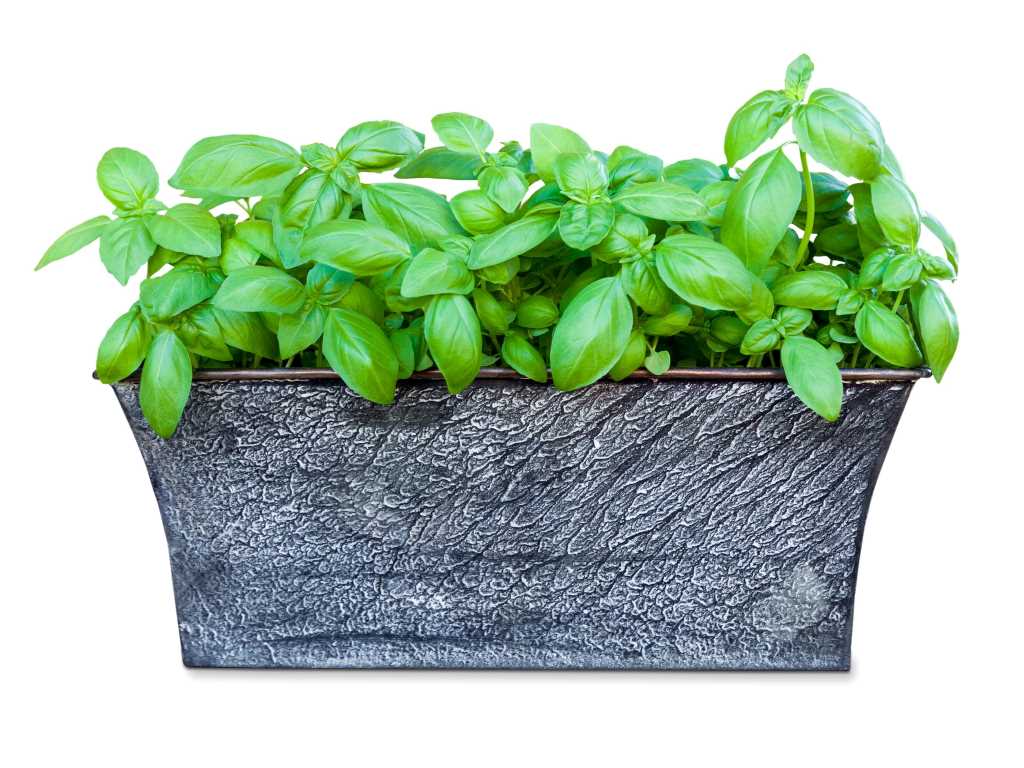
How to Grow Basil in Pots
Basil is a popular herb to grow in pots and containers. Growing basil in pots is convenient for those with limited space or who want to keep their herb garden close at hand. I keep mine in a big pot on my deck because that’s where I get the most bright morning sun in my yard. I’ll also keep a smaller pot all winter in my kitchen greenhouse window so I can snip fresh basil at any time.
With just a few extra steps you can grow massive basil plants in containers and stock your kitchen for the year. Here are some tips to help you grow basil in pots successfully.
Potted basil grows exceptionally well in kitchen windows or in a greenhouse for quick access year around.
Soil Preparation
Before planting your basil in a pot, it’s important to select a well-drained soil that is rich in nutrients. I like to use an organic potting mix that is specifically designed for container gardening. This type of soil is lightweight and contains a blend of organic matter to help feed your plant.
To prepare your soil, fill your container with potting soil mix. Leaving at least an inch of space at the top so dirt won’t overflow when you water. Plant your basil plant so the soil is at the same level it was in it’s original pot.
Container Selection
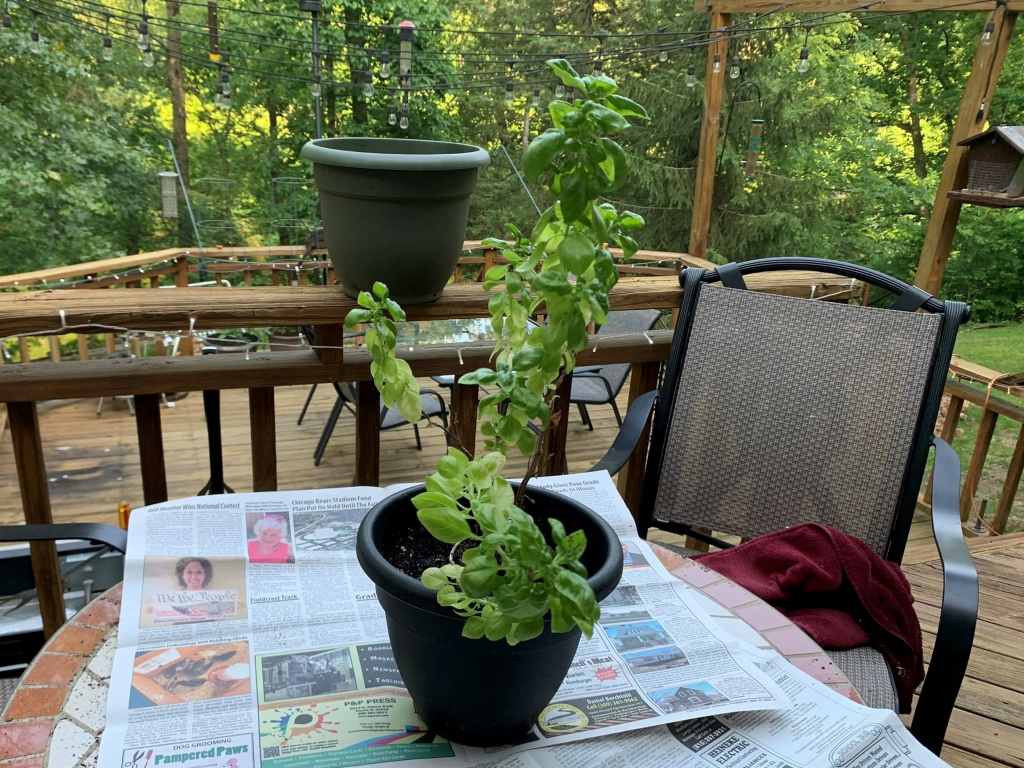
Growing basil in pots is a great way to enjoy fresh herbs all year round.
The container for growing basil should be large enough to accommodate the roots of your plants. For patio or balcony gardens you’ll want a pot at least 12 inches in diameter. A smaller pot will dry out too fast which will cause your basil to struggle. If you are potting basil for a kitchen window garden, you can usually get away with a 8 inch diameter pot for the winter. But it will need repotted after 6-9 months into a bigger planter.
It’s critical that any pot for growing herbs, basil included, have drainage holes to allow excess water to drain away. A container without drainage holes can lead to waterlogged soil and root rot. I see way more people having problems with over-watering basil than underwatering.
Caring for Basil Plants
Growing basil is easy, but caring for it is equally important to ensure that it grows healthy and produces flavorful leaves. In this section, we will discuss three essential aspects of caring for basil plants: watering, fertilizing, and pruning.
Watering
Basil plants need to be watered regularly, but overwatering can lead to root rot and other fungal diseases. You should water your basil plants deeply once a week or more often if the soil is dry. The soil should be moist, but not waterlogged. To check if the soil needs watering, stick your finger into the soil up to the first knuckle. If the soil feels dry, it’s time to water.
Fertilizing
Basil plants benefit from a light fertilizer regime. Basil doesn’t fare well when heavily fertilized. Starting with a soil that contains a lot of organic matter will feed your plants for the season. Then supplement with a balanced fertilizer at half the recommended rate on the label. For herb garden beds, I really like Burpee’s all natural organic fertilizer. And when growing herbs in containers I love to use a slow release like Osmocote’s flower and vegetable food.
Pruning
Pruning is essential for basil plants to grow bushy and produce more leaves. start your first pruning by pinching off the top two sets of leaves when the plant reaches about six inches in height to encourage the plant to branch out and produce more leaves. After that prune every 3-4 weeks, cutting back the stems about 1/3.
It’s important to prune any developing flower heads on basil plants and discard them. Flowers will pull nutrients from the leaves which results in a bitter taste.
And basil doesn’t like cold weather, so if there is a threat of early frost in the fall run out and harvest every bit of your basil you can. It might be your last chance.
Common Problems and Solutions
When growing basil in your garden, you’ll find it usually doesn’t have many pest or disease problems. But sometimes things don’t go as planned. Here are few problems you may encounter when growing basil and how to fix them.
Pests and Diseases
Basil is susceptible to a variety of pests and diseases that can damage the plant or even kill it. Here are some of the most common pests and diseases that affect basil and how to deal with them:
- Aphids: These tiny insects can suck the sap from the leaves and stems of your basil plant, causing them to wilt and die.
- Whiteflies: These small, winged insects can cause the leaves of your basil plant to turn yellow and fall off.
The best way to get rid of small bugs on your basil is to wash the plants with a strong force of water. That usually dislodges the intruders. If the infestation is severe then spray with an organic insecticidal soap. Or you can make your own spray with dish detergent and water. It take several sprays to get rid of these pesky bugs as you only remove the adults, not the eggs, each time. Repeat sprays are to get rid of newly hatched bugs and break the reproduction cycle.
- Fusarium wilt: This fungal disease can cause the leaves of your basil plant to turn yellow and wilt. To prevent fusarium wilt, make sure your basil plant is not overcrowded and that the soil is well-drained.
- Slugs will also feed on basil if the ground is too moist. If you find slugs in your basil, clear away any debris. Pick off and dispose of any slugs you find. You’ll likely need to apply diatomaceous dust, a natural solution to control slugs.
Cats and Other Critters

This is the first year I’ve run into critters munching on my basil. Yes, there are several mammals that love the sweet flavor as much as you. Cats, possums and mice are known to nibble and occasionally destroy basil. I’m suspect that the damage above was caused by a feral cat that has made his home under our deck. Brad’s going to put out a trail cam and see if we can catch him in action.
Harvesting and Preserving Basil
How to Harvest Basil
To get the best flavor and yield, start harvesting your basil when the plant has at least six sets of leaves. I like to let the stems get 6-10 inches long, and then harvest about 1/3 of the stem.

Clip the stem just above a set of leaves. That will help force the plant to branch out which will result in more stems of basil. It’s best to harvest in the morning when the plant is still cool and the oils are at their peak.
When harvesting your basil, be sure to pinch off any flowerheads you see. This will help the plant focus its energy on producing more foliage rather than flowers. Flowers pull nutrients out of the leaves and cause your basil to loose much of it’s sweet flavor.
Preserving Your Basil
Once you have harvested your basil, you can either use it fresh or preserve it for later use. While I prefer to cook with fresh or frozen basil, there are some recipes where dried basil is your best option. So since you are going to have a ton of basil using this growing guide, you might as well preserve some both ways!
Drying Basil
You can dry basil by hanging to dry, in a food dehydrator or in the oven. Hanging to naturally air dry seems to be best for retaining the most oils and flavor. To dry your basil, tie the stems together and hang them upside down in a cool, dry place for a few weeks. Once the leaves are dry, remove them from the stems and store them in an airtight container.
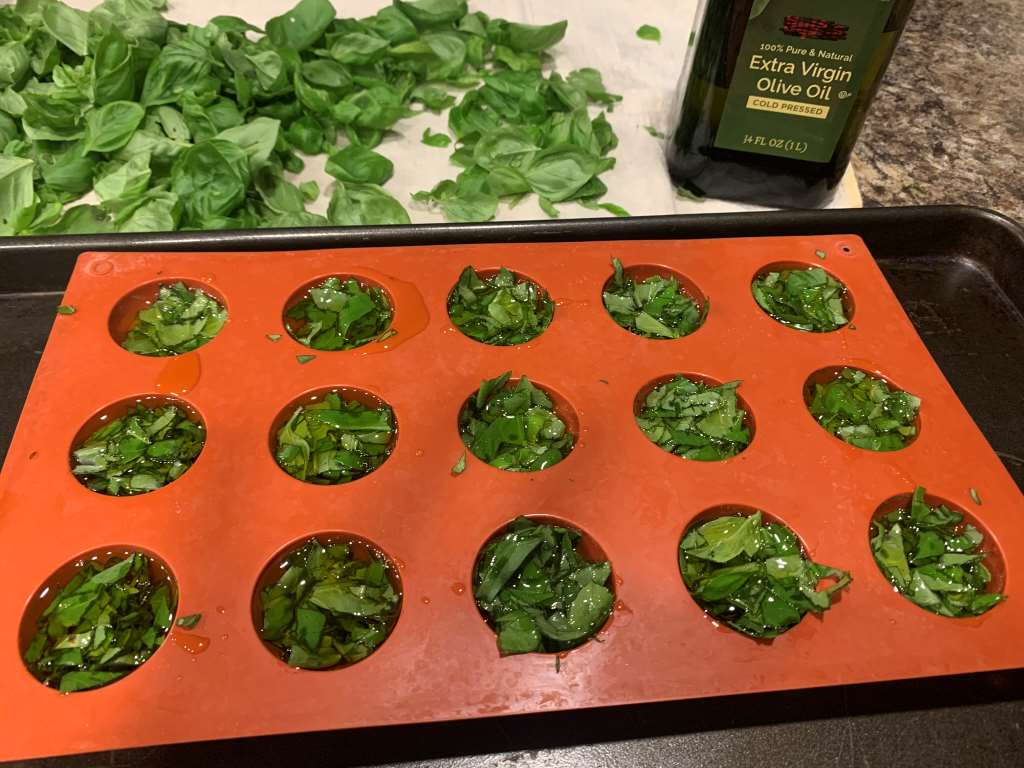
I love to freeze chopped basil leaves in ice cube trays with a little bit of olive oil. I love using my silicone molds because it is super easy to pop out the cubes after freezing. Once frozen, bag the cubes and store for up to 6 months. They are ready to pop right into your favorite pasta! You can also freeze whole leaves by placing in a freezer bag. Make sure you remove all the air before closing.
Choosing the Right Basil Variety
You’ll find dozens of cultivars of basil. Amazon has a prepackaged set of 8 of the most grown basil cultivars that contains. This is a good place to start if you want to test more flavors.
- The most common is sweet basil used for Italian cooking.
- Thai basil can also be found without much effort and is used in many Asian dishes.
- Genovese basil is the classic Italian basil with a sweet and spicy flavor, making it perfect for pesto and other Italian dishes.
- Lemon basil has a citrusy flavor and is great in teas, salads and seafood dishes.
- Great in teas, cinnamon basil has a spicy, cinnamon-like flavor.
- Italian basil has a milder, sweet flavor that’s perfect for many dishes.
- For a more intense flavor try one of the purple basils. The deep color of the leaves also adds visual variety to your herb garden.
- And red rubin, similar to purple basil, is great for vinegars.
In summary, when choosing a basil variety to grow, consider the flavor, appearance, growing conditions, and intended use.
Frequently Asked Questions
Basil is the perfect herb to grow in pots. It can be grown on patios or in a sunny kitchen window. Start with a pot that is at least 8 inches deep and has drainage holes at the bottom. Fill the pot with well-draining potting soil and plant the basil seedlings or seeds about ¼ inch deep. Basil loves to be well watered, as long as it is not standing in water.
Growing basil from a supermarket plant usually takes a little more effort than starting with a plant from your local garden center. To grow basil from a supermarket plant, start by transferring the plant to a larger pot that is at least 8 inches deep with fresh soil. Water the plant regularly and place it in a sunny location. Prune the plant to encourage new growth.
Pruning basil is essential to prevent the plant from becoming too leggy. To encourage fuller growth and an abundance of leaves, once stems are 5-8 inches long, cut off 1/3 of the stem right above a set of leaves. Also prune off any flower heads that start to form.
To harvest basil, clip off up to 1/3 of plant stems that are longer than 5 inches. You need to leave leaves behind on the stem to encourage new growth. Then use scissors or your fingers to remove the leaves from the stem. You can harvest basil throughout the growing season.
Yes, basil is a relatively easy herb to grow, especially for first time herb gardens. Basil prefers a sunny location and well-draining soil. It also requires regular watering.
A Few Last Thoughts on How to Grow Basil
I hope you enjoy taking advantage of this flavorful herb in your cooking as much as I have. It’s hard to go back to “grocery store” basil after you have tasted it straight from your garden. Here are some key takeaways to keep in mind as you embark on your basil-growing journey:
- Choose a sunny location with well-draining soil for your basil plants.
- Keep the soil moist but not waterlogged, and fertilize your plants regularly and lightly.
- Pinch off the tops of your basil plants to encourage bushier growth and prevent them from flowering too early.
- Harvest your basil leaves regularly to encourage new growth and avoid the plant becoming woody.
- Consider growing basil in pots if you don’t have access to a garden or want to keep your plants indoors.
Remember that when learning how to grow basil it’s important to be patient with yourself. But the good news is that basil is a very forgiving plant. And the end result is well worth it. You too can enjoy fresh, flavorful basil all season long. Happy growing!
